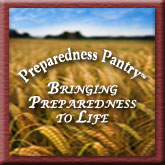It's been 6 years since my Mom passed away. For years before that she kept telling us to copy her recipes so we'd have them when she was gone. I only half listened. Dumb, as she was a fabulous cook, with many of her recipes ones that she spend a long time developing and perfecting. No looking them up in the Joy of Cooking. Mom was right, of course.
The deer left us enough apples that I needed a recipe. We just couldn't handle another apple pie, especially because I really don't have the 'good pie' gene. I looked through my recipe box and found one, sort of. Apple Crumble Puddling was one of Mom's special occasion recipes. That meant the company got the first shot and we kids got the left overs -- if there were any!
What I had written down, or she wrote down, was pretty cryptic: four ingredients with the measures and an oven temperature. Good thing I had some memory of how she made it or it would have been lost. So here's the real reconstructed Apple Crumble Pudding recipe:
Preheat oven to 325 degrees.
Generously butter a glass baking dish of your desired size.
In a medium sized bowl, dissolve 2 to 4 Tablespoons of sugar in a cup of water and add 2 T lemon juiice (reconstituted is OK). The mixture will retard the 'turning brown' process and help make up for spongy or less ripe apples -- so this is a good recipe for the less fortunate fruit! If you are using really sour apples, like thinners, increase the sugar by another tablespoon or two.
Take some apples and, if red or thick skinned, peel and core them. Thin-skinned yellow apples can just be washed and cored. Cut in half from blossom to stem end. Swish around in the bowl of lemon water for now until you have a few. When you have a few in the bowl, start slicing them, very thin -- like and eighth to 3/16 ths thick (they cook better that way) and put the slices back in the lemon water. When done slicing that load, remove from the lemon water and arrange in the baking dish. I usually repeat this process until I have about 2 inches of apple slices in the dish.
Now for the part on the recipe card!
Mix 1/2 cup each of butter (cold or soft, not melted) and flour, 3/4 cup brown sugar ( I prefer dark brown) and 1/4 cup rolled oats (not the 1 minute kind) until well mixed. I often up the oats to 1/3 cup and add a little cinnamon ( half teaspoon max) and a pinch of cardamom -- not enough to really taste, just to enhance the buttery flavor of the topping. You can make up to a 9" X 13" pan with this recipe amount.
Sprinkle about a third of the mixture into the sliced apples and mix a bit, them smooth the slices back down. Sprinkle another third on top. Bake for about 30 to 40 minutes until the apples soften but are not mushy.
Turn the heat up to 375. Sprinkle the last third of the topping on the top of the dish. Bake another 15 minutes.
You can either cut the slightly cooled dessert our with a spatula or spoon it out. Either way, keep the topping up or it will get soggy. Serve warm with whipped cream or ice cream.
You will be surprised how these simple ingredients turn into something wonderful!
Thanks, Mom!




 What's to see? Parking lot, ball field, light post. Boring!
What's to see? Parking lot, ball field, light post. Boring! Not where one would expect some rare, amazing wildlife, but it's there. Look a little closer.
Not where one would expect some rare, amazing wildlife, but it's there. Look a little closer. Those little rascals are pipevine swallowtail caterpillars on a rare occurrence of pipevine (at least in this part of the desert southwest), their larval food source.
Those little rascals are pipevine swallowtail caterpillars on a rare occurrence of pipevine (at least in this part of the desert southwest), their larval food source. To see what they will become,
To see what they will become, 


































